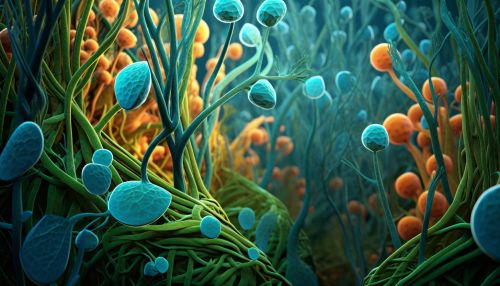Abscisic Acid
Introduction
Abscisic acid (ABA) is a plant hormone that plays a crucial role in plant development and stress response. It is one of the five major plant hormones, along with auxins, cytokinins, gibberellins, and ethylene. ABA is involved in various plant processes such as seed development, dormancy, germination, growth, and response to environmental stresses like drought and cold 1.


History and Discovery
The discovery of ABA dates back to the early 1960s when two independent research groups identified a substance that promoted abscission (leaf drop) and dormancy in plants. The substance was named "abscisin II" by one group and "dormin" by the other. Later, it was found that both substances were identical and the name "abscisic acid" was adopted 2.
Structure and Synthesis
ABA is a sesquiterpene, which means it is composed of three isoprene units. Its synthesis occurs in the plastids of plant cells and involves several enzymatic reactions. The precursor of ABA is a carotenoid called zeaxanthin, which is converted into violaxanthin and then into neoxanthin. The enzyme neoxanthin dioxygenase (NDC) cleaves neoxanthin to form xanthoxin, which is then converted into ABA aldehyde and finally into ABA 3.


Functions
ABA has numerous functions in plants, including:
Seed Development and Dormancy
ABA plays a key role in seed development and dormancy. It promotes the accumulation of storage proteins and lipids in developing seeds and induces seed dormancy by inhibiting the growth of the embryo. This dormancy can be broken by environmental cues such as light and temperature, or by the decrease in ABA levels 4.
Stomatal Closure
ABA regulates the opening and closing of stomata, the small pores on the surface of leaves that allow gas exchange. In response to drought stress, ABA levels increase, leading to the closure of stomata to prevent water loss 5.
Response to Environmental Stress
ABA is a key player in the plant's response to environmental stresses such as drought, cold, and salinity. It triggers various adaptive responses, including stomatal closure, synthesis of stress proteins, and accumulation of osmolytes to maintain cell turgor 6.
Growth Inhibition
ABA can inhibit plant growth by antagonizing the action of growth-promoting hormones like auxins and gibberellins. It can inhibit cell division and elongation, and promote senescence (aging) in leaves 7.


Signaling Pathway
The ABA signaling pathway involves perception of ABA by receptors, signal transduction, and response. The main ABA receptors in plants are the PYR/PYL/RCAR family of proteins. When ABA binds to these receptors, they inhibit a group of enzymes called protein phosphatases (PP2Cs). This inhibition allows another group of enzymes, protein kinases (SnRK2s), to phosphorylate and activate various proteins, leading to the ABA response 8.
Role in Agriculture
Due to its role in stress response, ABA has potential applications in agriculture. It can be used to enhance crop tolerance to environmental stresses like drought and salinity. Moreover, ABA can be used to control seed dormancy and germination, which can be beneficial in seed production and storage 9.


See Also
References
1. Cutler S.R., Rodriguez P.L., Finkelstein R.R., Abrams S.R. (2010). Abscisic acid: emergence of a core signaling network. Annual Review of Plant Biology, 61, 651-679. 2. Milborrow B.V. (2001). The pathway of biosynthesis of abscisic acid in vascular plants: a review of the present state of knowledge of ABA biosynthesis. Journal of Experimental Botany, 52, 1145-1164. 3. Finkelstein R. (2013). Abscisic Acid synthesis and response. The Arabidopsis Book, 11, e0166. 4. Nambara E., Marion-Poll A. (2005). Abscisic acid biosynthesis and catabolism. Annual Review of Plant Biology, 56, 165-185. 5. Kim T.H., Böhmer M., Hu H., Nishimura N., Schroeder J.I. (2010). Guard cell signal transduction network: advances in understanding abscisic acid, CO2, and Ca2+ signaling. Annual Review of Plant Biology, 61, 561-591. 6. Fujita Y., Fujita M., Shinozaki K., Yamaguchi-Shinozaki K. (2011). ABA-mediated transcriptional regulation in response to osmotic stress in plants. Journal of Plant Research, 124, 509-525. 7. Seo M., Koshiba T. (2002). Complex regulation of ABA biosynthesis in plants. Trends in Plant Science, 7, 41-48. 8. Ma Y., Szostkiewicz I., Korte A., Moes D., Yang Y., Christmann A., Grill E. (2009). Regulators of PP2C phosphatase activity function as abscisic acid sensors. Science, 324, 1064-1068. 9. Sah S.K., Reddy K.R., Li J. (2016). Abscisic acid and abiotic stress tolerance in crop plants. Frontiers in Plant Science, 7, 571.
